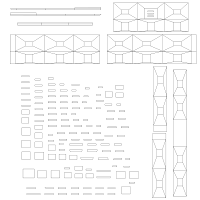Anyway, in terms of the exhibition, I produced a showreel as my main asset, which I also produced some extra imagery from my developing knowledge of the vray renderer. The imagery I created is of an interior space and is quite simple in terms of design, but I think the quality and realism of the renderer is much higher than I have achieved previously with the Mental Ray renderer. So far, for the showreel and exhibition pieces, I used a bright daylight set-up using vray lighting, such as vray sun, vray light, and global illumination settings.
Here are the two stills I managed to render in time for these exhibition assets:
As I say, these then became part of my final short showreel for the exhibition and my website, featuring the best of my work that fits within the specific field of 3D visualisation. This included my vray interior visualisation, the 'Castle Attack' client project, the ATRG internal client advert, examples of my research artefacts, and my 'Still Life' objects from last year.
3D Visualisation Showreel 2013 from Samantha Freeman on Vimeo.
I am now using this scene I created with vray to experiment with lighting using the renderer - such as night scenes and similar tests to what I did in my research project - in order to get the best portfolio I can.


















































